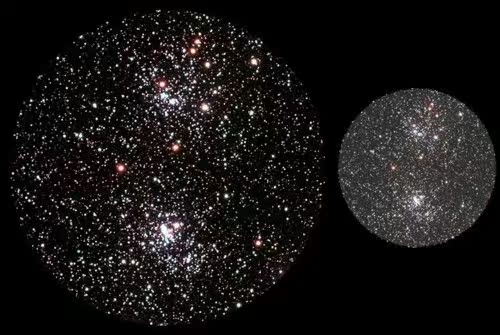Televue8mm Ethos Eyepiece - 1.25"/2"
- TheTelevue 8mm Ethos eyepieceprovides a 100° apparent field for a true "spacewalk" view of the night sky.
- Distortion correction, high contrast and on-axis sharpness for planetary viewing.
- Televue 8mm Ethos eyepieceprovides a generous 15mm of eye relief for comfortable observing.
- Accepts DIOPTRX eyesight astigmatism correctors.
- TheTelevue 8mm Ethos eyepiecewill fit either 2" or 1.25" barrel sizes and weighs 0.95 lbs (15.2 oz.).
- Dramatic high magnification views combine with stunning wide field backgrounds suitable for use with binocular viewers.
|
For those attending NEAF 2008, we were eagerly awaiting Televue to demonstrate their new 8mm focal length, 100° apparent field of view Ethos eyepiece. We weren't disappointed...
Ethos principal designer, Paul Dellechiaie, is flanked by Al (left) and David Nagler (right) for the announcement of the new Ethos 8mm 100° eyepiece at the NorthEast Astronomy Forum (NEAF) in Suffern, NY, on April 26, 2008.
Televue 8mm Ethos Eyepiece
The Tele Vue Ethos eyepieces have pushed the boundries of optical excellence and maximum field of view, creating an unrivaled eyepiece experience. An important benefit of the combination of large apparent field of view and shorter focal length is that for a given field in the sky, higher magnification results in a darker sky background. Fainter stars become visible and more detail is seen on all deep sky objects. The Tele Vue Ethos eyepiece provides another big magnification/contrast jump, yielding dramatic views simply not previously possible in any telescope. With the smaller exit pupil, eyesight limitations are also reduced. The Televue 8mm Ethos delivers: 100° apparent field (50% larger in area than 82° Naglers), comfortable eye-relief, accepts DIOPTRX eyesight astigmatism correctors, distortion correction, high contrast and on-axis sharpness for planetary viewing. It is the “do-it-all” eyepiece perfect for all scopes that can utilize this focal length.

Celebrate the start of the International Year of Astronomy 2009, the 400th anniversary of Galileo's first use of an astronomical telescope, by showing friends and neighbors the best of our wonderful universe. The Tele Vue philosophy (Ethos, if you will) has always been about inspiring “spacewalk” vistas by creating the finest “rich field” refractors and wide angle eyepieces. We hope the introduction of these new Ethos models will further rekindle the appreciation of astronomy and support all the worthy goals of IYA 2009. It’s been quite a challenge to develop new Ethos eyepieces to the same performance standards achieved by the 13mm and 8mm models, perhaps the most honored in history. We hope the increased field of the 17mm and increased power of the 6mm will open up new visual experiences that Galileo could hardly have imagined, from small refractors to the largest Dobsonians.
The "Majesty Factor" of the TeleVue Ethos Eyepiece
 Majesty Factor Visualization: 13-mm Ethos (left) and 26-mm Plössl (right) have same true field of the Double Cluster. But Ethos has twice the power factor and four times the contrast factor. Ethos therefore has a Majesty Factor of eight relative to the Plössl's Majesty Factor of one. For reference, the 0.9° true field shown could be produced by a 14" f/4 telescope using the 100° Ethos at 109x with a 3.2mm exit pupil or the 26-mm 50° Plössl at 55x with a 6.5mm exit pupil. -- TV60is image of Double Cluster by Robert Reeves
Majesty Factor Visualization: 13-mm Ethos (left) and 26-mm Plössl (right) have same true field of the Double Cluster. But Ethos has twice the power factor and four times the contrast factor. Ethos therefore has a Majesty Factor of eight relative to the Plössl's Majesty Factor of one. For reference, the 0.9° true field shown could be produced by a 14" f/4 telescope using the 100° Ethos at 109x with a 3.2mm exit pupil or the 26-mm 50° Plössl at 55x with a 6.5mm exit pupil. -- TV60is image of Double Cluster by Robert Reeves
 "To illustrate the dramatic effect of combining a larger apparent field (yielding greater deep sky details) with smaller exit pupils (yielding fainter stars with darker sky background) we propose the "Majesty Factor". We define it simply as the cube of the ratio of any two different apparent field eyepieces having the same field stop diameters (same true field). Examples:
"To illustrate the dramatic effect of combining a larger apparent field (yielding greater deep sky details) with smaller exit pupils (yielding fainter stars with darker sky background) we propose the "Majesty Factor". We define it simply as the cube of the ratio of any two different apparent field eyepieces having the same field stop diameters (same true field). Examples:
(100°/70°)3 = 2.92 "M.F." or (70°/50°)3 = 2.74 "M.F." or(100°/50°)3 = 8 "M.F."
After showing Ethos at a number of events since April 2007, we can safely conclude it brings the observing experience to a new level. This is based solely on user's reactions to views of familiar objects, not on any prejudgments, publicity or hype on our part. While we were quite confident of success, we wanted, and still want, to explore all the ramifications of what a sharp 100° field really represents. Right after NEAF in April, Rodger Gordon, the acknowledged "eyepiece junkie" of all time, wrote me "Definitely the finest wide-angle eyepiece I've ever seen. If God is an astronomer, this is the wide-angle eyepiece he'd choose. You can quote me." Thanks, Rodger. I waited until now to avoid "priming the pump", so to speak before quoting your unbridled enthusiasm publicly.
For some time, I've been pondering just why the response has been so overwhelmingly positive. And if I really understand why, is it possible to quantify? My views of the Double Cluster at Stellafane pointed the way. The 1991 article I wrote for Sky and Telescope on magnification provides the key. A major conclusion for low power states: "The best view occurs with the highest power that comfortably includes the target object. Higher powers darken the background sky, reveal fainter stars and show more detail. The resulting smaller exit pupil also minimizes the effects of eyesight defects. Considering the potential of Ethos, let me posit a more general conclusion:
For deep sky viewing of star fields, open and globular clusters, nebulae and galaxies, choose the highest power that frames the subject, so long as the sky background does not reach black, and the atmosphere does not degrade the resolution. The smaller exit pupils permit a darker sky background which achieves greater contrast against the fixed brightness of stars, while the greater magnification reveals more structural details on extended objects. Using eyepieces with larger apparent fields maximizes the viewing experience. The result is an increase in what I would call the Majesty Factor, the nexus of contrast, power and field.
It's clear that the largest possible apparent field for a given true field yields the most magnification for greater resolution, with a darker sky background for more contrast as a result of the smaller exit pupil. I believe this combination of contrast, power and field causes the typical "wow" reaction — the Majesty Factor. I think Tom Trusock said it most succinctly in his Starfest (Canada) report: "The same true field at higher magnification means that you'll see blacker skies and more detail." Dennis di Cicco in his 5-star review of Ethos in his October 2007 Sky & Telescope review noted something similar: "Observing with the 12-inch scope, I typically bounce between a wide-field eyepiece for star-hopping and a high-power one for detailed views. But the Ethos gave me both. The field was large enough to star-hop, and the magnification was high enough to bring out faint stars and resolve details in galaxies and star clusters." (He coincidently also illustrated field sizes using the Double Cluster.) Let's try to quantify the so-called Majesty Factor.
While we cannot quantify the majesty of a great symphony, work of art or edifice, I think a meaningful Majesty Factor is quantifiable for those great deep sky views. Let's consider a range of possible eyepieces with apparent fields of 50°, 60°, 68°, 82° and 100°. Now let's pick an object, (like the Double Cluster) and let's say it's properly framed in the field of a 50° Plössl with a 26-mm focal length in an f/4 telescope so the exit pupil = 6.5-mm. Let's arbitrarily assign a factor of 1 to the power (magnification) of this telescope and a factor of 1 to represent the contrast for the 6.5-mm exit pupil. Therefore, for the given true field, the Majesty Factor = 1 (power factor) x 1 (contrast factor) = 1.
Now let's replace the Plössl with a 100° (apparent field) Ethos with a 13-mm focal length. This yields the same true field of view at twice the power with twice the apparent field and half the exit pupil. The 3.2-mm exit pupil is only ¼ the area of 6.5-mm, so the sky background darkens by a factor of 4 (contrast factor). The magnification power factor yields twice the detail or resolution. Therefore: 2 (power factor) x 4 (contrast factor) = 8x Majesty Factor. A simple rule of thumb is that for any two eyepieces having the same true field of view, the Majesty Factor equals the cube of their apparent field ratios. Example is (100°/70°)3=2.92."-- Al Nagler
TeleVue Product Number:ETH-08.0
All Televue products are available to ship world-wide from OPT, and effective July 1, 2008, are covered by a Five Year Worldwide Limited Product Warranty! Always be sure to save your original packaging materials should you need to return any Televue product for warranty or repair.
User Reviews
|
 | Review Date: 7/3/2008
Reviewed By: Stephen E. Russell |
OMG, the 8 Ethos.....what can I say. Finally Sunday night at midnight I set up FC-76 to try out the new 8 Ethos along with the 13 Ethos and compare them to the 8, 13, and 17 Baader Hyperions. The 8 just like its bigger sibling is just simply outstanding! Two things that immediately jumped out at me, the
stars are tighter/sharper and brighter when comparing the Ethos to the Hyperions. The sharper star images make the stars appear brighter to my eyes. I have no idea many elements and or what sort of hybrid molded aspherics are in the Ethos according to the rumors of the design, but they just do not get in the way of the views. At f 7.9 in the FC76 s the stars
looked sharp all the way out to the edge as you pan around to view the entire field. No trouble with blackouts and I can see the entire 100 AFOV at once, you just have to concentrate on the area within the field of view you want... |
|